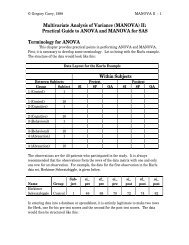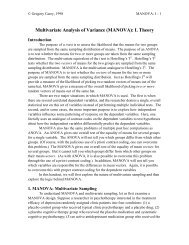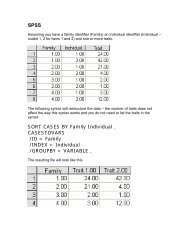Introduction to Matrix Algebra (pdf file)
Introduction to Matrix Algebra (pdf file)
Introduction to Matrix Algebra (pdf file)
You also want an ePaper? Increase the reach of your titles
YUMPU automatically turns print PDFs into web optimized ePapers that Google loves.
Psychology 7291: Multivariate Statistics (Carey) 8/27/98 <strong>Matrix</strong> <strong>Algebra</strong> - 1<br />
<strong>Introduction</strong> <strong>to</strong> <strong>Matrix</strong> <strong>Algebra</strong><br />
Definitions:<br />
A matrix is a collection of numbers ordered by rows and columns. It is cus<strong>to</strong>mary<br />
<strong>to</strong> enclose the elements of a matrix in parentheses, brackets, or braces. For example, the<br />
following is a matrix:<br />
5 8 2<br />
X =<br />
⎛ ⎜ ⎞<br />
⎝ −1 0 7⎠ .<br />
This matrix has two rows and three columns, so it is referred <strong>to</strong> as a “2 by 3” matrix. The<br />
elements of a matrix are numbered in the following way:<br />
⎛ x 11<br />
x 12<br />
x 13<br />
X = ⎜<br />
⎞<br />
⎟<br />
⎝ x 21<br />
x 22<br />
x 23<br />
⎠<br />
That is, the first subscript in a matrix refers <strong>to</strong> the row and the second subscript refers <strong>to</strong><br />
the column. It is important <strong>to</strong> remember this convention when matrix algebra is<br />
performed.<br />
A vec<strong>to</strong>r is a special type of matrix that has only one row (called a row vec<strong>to</strong>r) or<br />
one column (called a column vec<strong>to</strong>r). Below, a is a column vec<strong>to</strong>r while b is a row<br />
vec<strong>to</strong>r.<br />
⎛ 7⎞<br />
a =<br />
2<br />
⎜ ⎟ , b = ( −2 7 4 )<br />
⎝ 3⎠<br />
A scalar is a matrix with only one row and one column. It is cus<strong>to</strong>mary <strong>to</strong> denote<br />
scalars by italicized, lower case letters (e.g., x), <strong>to</strong> denote vec<strong>to</strong>rs by bold, lower case letters<br />
(e.g., x), and <strong>to</strong> denote matrices with more than one row and one column by bold, upper<br />
case letters (e.g., X).<br />
A square matrix has as many rows as it has columns. <strong>Matrix</strong> A is square but<br />
matrix B is not square:<br />
A = 1 6 ⎛ 1 9⎞<br />
⎛<br />
⎜ ⎞<br />
⎟ , B = 0 3<br />
⎝ 3 2⎠<br />
⎜ ⎟<br />
⎝ 7 −2⎠<br />
A symmetric matrix is a square matrix in which x ij<br />
= x ji<br />
for all i and j. <strong>Matrix</strong> A is<br />
symmetric; matrix B is not symmetric.<br />
⎛ 9 1 5⎞<br />
⎛ 9 1 5⎞<br />
A =<br />
⎜<br />
1 6 2<br />
⎟ , B = ⎜<br />
2 6 2<br />
⎟<br />
⎝ 5 2 7⎠<br />
⎝ 5 1 7⎠<br />
A diagonal matrix is a symmetric matrix where all the off diagonal elements are<br />
0. <strong>Matrix</strong> A is diagonal.
Psychology 7291: Multivariate Statistics (Carey) 8/27/98 <strong>Matrix</strong> <strong>Algebra</strong> - 2<br />
⎛ 9 0 0⎞<br />
A =<br />
0 6 0<br />
⎜ ⎟<br />
⎝ 0 0 7⎠<br />
An identity matrix is a diagonal matrix with 1s and only 1s on the diagonal. The<br />
identity matrix is almost always denoted as I.<br />
⎛ 1 0 0⎞<br />
I =<br />
0 1 0<br />
⎜ ⎟<br />
⎝ 0 0 1⎠<br />
<strong>Matrix</strong> Addition and Subtraction:<br />
To add two matrices, they both must have the same number of rows and they both<br />
must have the same number of columns. The elements of the two matrices are simply<br />
added <strong>to</strong>gether, element by element, <strong>to</strong> produce the results. That is, for R = A+ B, then<br />
r ij<br />
= a ij<br />
+ b ij<br />
for all i and j. Thus,<br />
⎛<br />
⎜<br />
9 5 1⎞<br />
⎛<br />
⎟ = ⎜<br />
1 9 −2⎞<br />
⎛<br />
⎟ + ⎜<br />
8 −4 3⎞<br />
⎟<br />
⎝ −4 7 6⎠<br />
⎝ 3 6 0⎠<br />
⎝ −7 1 6⎠<br />
<strong>Matrix</strong> subtraction works in the same way, except that elements are subtracted instead of<br />
added.<br />
<strong>Matrix</strong> Multiplication:<br />
There are several rules for matrix multiplication. The first concerns the<br />
multiplication between a matrix and a scalar. Here, each element in the product matrix is<br />
simply the scalar multiplied by the element in the matrix. That is, for R = aB, then<br />
r ij<br />
= ab ij<br />
for all i and j. Thus,<br />
⎛<br />
8⎜<br />
2 6 ⎞ ⎛<br />
⎟ = ⎜<br />
16 48⎞<br />
⎟<br />
⎝ 3 7⎠<br />
⎝ 24 56⎠<br />
<strong>Matrix</strong> multiplication involving a scalar is commutative. That is, aB = Ba.<br />
The next rule involves the multiplication of a row vec<strong>to</strong>r by a column vec<strong>to</strong>r. To<br />
perform this, the row vec<strong>to</strong>r must have as many columns as the column vec<strong>to</strong>r has rows.<br />
For example,<br />
⎛ 2⎞<br />
( 1 7 5)<br />
4<br />
⎜ ⎟<br />
⎝ 1⎠<br />
is legal. However
Psychology 7291: Multivariate Statistics (Carey) 8/27/98 <strong>Matrix</strong> <strong>Algebra</strong> - 3<br />
⎛ 2⎞<br />
⎜ 4⎟<br />
( 1 7 5)<br />
⎜<br />
⎜<br />
1<br />
⎟<br />
⎝ 6⎠<br />
is not legal because the row vec<strong>to</strong>r has three columns while the column vec<strong>to</strong>r has four<br />
rows. The product of a row vec<strong>to</strong>r multiplied by a column vec<strong>to</strong>r will be a scalar. This<br />
scalar is simply the sum of the first row vec<strong>to</strong>r element multiplied by the first column<br />
vec<strong>to</strong>r element plus the second row vec<strong>to</strong>r element multiplied by the second column<br />
vec<strong>to</strong>r element plus the product of the third elements, etc. In algebra, if r = ab, then<br />
n<br />
r = ∑a i<br />
b i<br />
i =1<br />
Thus,<br />
⎛ 8⎞<br />
( 2 6 3)<br />
1<br />
⎜<br />
= 2∗8 + 6∗1 + 3∗4 = 34<br />
⎟<br />
⎝ 4⎠<br />
All other types of matrix multiplication involve the multiplication of a row vec<strong>to</strong>r<br />
and a column vec<strong>to</strong>r. Specifically, in the expression R = AB,<br />
r ij<br />
= a i •<br />
b •j<br />
where a i•<br />
is the ith row vec<strong>to</strong>r in matrix A and b •j<br />
is the jth column vec<strong>to</strong>r in matrix B.<br />
Thus, if<br />
A = 2 8 −1 ⎛ 1 7⎞<br />
⎛<br />
⎜ ⎞<br />
⎟ ,and B = 9 −2<br />
⎝ 3 6 4⎠<br />
⎜ ⎟<br />
⎝ 6 3⎠<br />
then<br />
⎛ 1⎞<br />
r 11<br />
= a 1•<br />
b •1<br />
= ( 2 8 1)<br />
9<br />
⎜<br />
= 2∗1 + 8∗9 + 1∗6 = 80<br />
⎟<br />
⎝ 6⎠<br />
and<br />
⎛ 7⎞<br />
r 12<br />
= a 1•<br />
b •2<br />
= ( 2 8 1)<br />
−2<br />
⎜<br />
= 2∗7 + 8∗(−2) + 1∗3 = 1<br />
⎟<br />
⎝ 3⎠<br />
and<br />
⎛ 1⎞<br />
r 21<br />
= a 2•<br />
b •1<br />
= ( 3 6 4)<br />
9<br />
⎜<br />
= 3∗1 + 6∗9 + 4∗6 = 81<br />
⎟<br />
⎝ 6⎠<br />
and
Psychology 7291: Multivariate Statistics (Carey) 8/27/98 <strong>Matrix</strong> <strong>Algebra</strong> - 4<br />
⎛ 7⎞<br />
r 22<br />
= a 2•<br />
b •2<br />
= ( 3 6 4)<br />
−2<br />
⎜<br />
= 3∗7 + 6∗(−2) + 4∗3 = 21<br />
⎟<br />
⎝ 3⎠<br />
Hence,<br />
⎛ 1 7⎞<br />
⎛<br />
⎜<br />
2 8 −1⎞<br />
⎟<br />
9 −2<br />
⎝ 3 6 4⎠<br />
⎜ ⎟ = ⎛<br />
⎜<br />
80 1 ⎞<br />
⎟<br />
⎝ 81 21⎠<br />
⎝ 6 3⎠<br />
For matrix multiplication <strong>to</strong> be legal, the first matrix must have as many columns as the<br />
second matrix has rows. This, of course, is the requirement for multiplying a row vec<strong>to</strong>r<br />
by a column vec<strong>to</strong>r. The resulting matrix will have as many rows as the first matrix and<br />
as many columns as the second matrix. Because A has 2 rows and 3 columns while B has<br />
3 rows and 2 columns, the matrix multiplication may legally proceed and the resulting<br />
matrix will have 2 rows and 2 columns.<br />
Because of these requirements, matrix multiplication is usually not commutative.<br />
That is, usually AB ≠ BA . And even if AB is a legal operation, there is no guarantee that<br />
BA will also be legal. For these reasons, the terms premultiply and postmultiply are often<br />
encountered in matrix algebra while they are seldom encountered in scalar algebra.<br />
One special case <strong>to</strong> be aware of is when a column vec<strong>to</strong>r is postmultiplied by a row<br />
vec<strong>to</strong>r. That is, what is<br />
⎛ −3⎞<br />
4<br />
⎜ ⎟<br />
( 8 2 ) <br />
⎝ 7⎠<br />
In this case, one simply follows the rules given above for the multiplication of two<br />
matrices. Note that the first matrix has one column and the second matrix has one row,<br />
so the matrix multiplication is legal. The resulting matrix will have as many rows as the<br />
first matrix (3) and as many columns as the second matrix (2). Hence, the result is<br />
⎛ −3⎞<br />
⎛ −24 −6⎞<br />
⎜<br />
4<br />
⎟<br />
( 8 2 ) =<br />
32 8<br />
⎜ ⎟<br />
⎝ 7⎠<br />
⎝ 56 14⎠<br />
Similarly, multiplication of a matrix times a vec<strong>to</strong>r (or a vec<strong>to</strong>r times a matrix) will also<br />
conform <strong>to</strong> the multiplication of two matrices. For example,<br />
⎛ 8 5⎞<br />
⎛ 2⎞<br />
⎜<br />
6 1<br />
8<br />
⎟ ⎜ ⎟<br />
⎝ 9 4⎠<br />
⎝ 5⎠<br />
is an illegal operation because the number of columns in the first matrix (2) does not<br />
match the number of rows in the second matrix (3). However,
Psychology 7291: Multivariate Statistics (Carey) 8/27/98 <strong>Matrix</strong> <strong>Algebra</strong> - 5<br />
⎛ 8 5⎞<br />
⎛<br />
6 1<br />
⎜<br />
3 ⎞<br />
⎛ 8∗3 + 5∗7⎞<br />
⎛ 59⎞<br />
⎟<br />
⎜ =<br />
6∗3 +1∗7<br />
⎟ ⎝ 7⎠<br />
⎜ ⎟ = 25<br />
⎜ ⎟<br />
⎝ 9 4⎠<br />
⎝ 9∗3 + 4∗7⎠<br />
⎝ 55⎠<br />
and<br />
⎛ 8 5⎞<br />
( 2 7 3)<br />
6 1<br />
⎜<br />
=<br />
⎟<br />
( 2∗8 + 7∗6 + 3∗9 2∗5 + 7∗1 + 3∗4) = ( 85 29)<br />
⎝ 9 4⎠<br />
The last special case of matrix multiplication involves the identity matrix, I. The<br />
identity matrix operates as the number 1 does in scalar algebra. That is, any vec<strong>to</strong>r or<br />
matrix multiplied by an identity matrix is simply the original vec<strong>to</strong>r or matrix. Hence, aI =<br />
a, IX = X, etc. Note, however, that a scalar multiplied by an identify matrix becomes a<br />
diagonal matrix with the scalars on the diagonal. That is,<br />
⎛<br />
4⎜<br />
1 0 ⎞ ⎛<br />
⎟ = ⎜<br />
4 0⎞<br />
⎟<br />
⎝ 0 1⎠<br />
⎝ 0 4⎠<br />
not 4. This should be verified by reviewing the rules for multiplying a scalar and a matrix<br />
given above.<br />
<strong>Matrix</strong> Transpose:<br />
The transpose of a matrix is denoted by a prime ( A ′ ) or a superscript t or T ( A t or<br />
A T ). The first row of a matrix becomes the first column of the transpose matrix, the<br />
second row of the matrix becomes the second column of the transpose, etc. Thus,<br />
A = 2 7 1<br />
⎛ 2 8⎞<br />
⎛<br />
⎜ ⎞<br />
⎟ , and A<br />
t<br />
=<br />
7 6<br />
⎝ 8 6 4⎠<br />
⎜ ⎟<br />
⎝ 1 4⎠<br />
The transpose of a row vec<strong>to</strong>r will be a column vec<strong>to</strong>r, and the transpose of a column<br />
vec<strong>to</strong>r will be a row vec<strong>to</strong>r. The transpose of a symmetric matrix is simply the original<br />
matrix.<br />
<strong>Matrix</strong> Inverse:<br />
In scalar algebra, the inverse of a number is that number which, when multiplied<br />
by the original number, gives a product of 1. Hence, the inverse of x is simple 1/x. or, in<br />
slightly different notation, x −1 . In matrix algebra, the inverse of a matrix is that matrix<br />
which, when multiplied by the original matrix, gives an identity matrix. The inverse of a<br />
matrix is denoted by the superscript “-1”. Hence,<br />
AA −1 = A −1 A = I<br />
A matrix must be square <strong>to</strong> have an inverse, but not all square matrices have an<br />
inverse. In some cases, the inverse does not exist. For covariance and correlation<br />
matrices, an inverse will always exist, provided that there are more subjects than there are<br />
variables and that every variable has a variance greater than 0.
Psychology 7291: Multivariate Statistics (Carey) 8/27/98 <strong>Matrix</strong> <strong>Algebra</strong> - 6<br />
It is important <strong>to</strong> know what an inverse is in multivariate statistics, but it is not<br />
necessary <strong>to</strong> know how <strong>to</strong> compute an inverse.<br />
Determinant of a <strong>Matrix</strong>:<br />
The determinant of a matrix is a scalar and is denoted as |A| or det(A). The determinant<br />
has very important mathematical properties, but it is very difficult <strong>to</strong> provide a<br />
substantive definition. For covariance and correlation matrices, the determinant is a<br />
number that is sometimes used <strong>to</strong> express the “generalized variance” of the matrix. That<br />
is, covariance matrices with small determinants denote variables that are redundant or<br />
highly correlated. Matrices with large determinants denote variables that are independent<br />
of one another. The determinant has several very important properties for some<br />
multivariate stats (e.g., change in R 2 in multiple regression can be expressed as a ratio of<br />
determinants.) Only idiots calculate the determinant of a large matrix by hand. We will<br />
try <strong>to</strong> avoid them.<br />
Trace of a <strong>Matrix</strong>:<br />
The trace of a matrix is sometimes, although not always, denoted as tr(A). The trace<br />
is used only for square matrices and equals the sum of the diagonal elements of the<br />
matrix. For example,<br />
⎛ 3 7 2⎞<br />
tr<br />
-1 6 4<br />
⎜ ⎟ = 3 + 6 − 5 = 4<br />
⎝ 9 0 -5⎠<br />
Orthogonal Matrices:<br />
Only square matrices may be orthogonal matrices, although not all square matrices<br />
are orthogonal matrices. An orthogonal matrix satisfied the equation<br />
AA t = I<br />
Thus, the inverse of an orthogonal matrix is simply the transpose of that matrix.<br />
Orthogonal matrices are very important in fac<strong>to</strong>r analysis. Matrices of eigenvec<strong>to</strong>rs<br />
(discussed below) are orthogonal matrices.<br />
Eigenvalues and Eigenvec<strong>to</strong>rs<br />
The eigenvalues and eigenvec<strong>to</strong>rs of a matrix play an important part in<br />
multivariate analysis. This discussion applies <strong>to</strong> correlation matrices and covariance<br />
matrices that (1) have more subjects than variables, (2) have variances > 0.0, and (3) are<br />
calculated from data having no missing values, and (4) no variable is a perfect linear<br />
combination of the other variables. Any such covariance matrix C can be mathematically<br />
decomposed in<strong>to</strong> a product:
Psychology 7291: Multivariate Statistics (Carey) 8/27/98 <strong>Matrix</strong> <strong>Algebra</strong> - 7<br />
C = ADA -1<br />
where A is a square matrix of eigenvec<strong>to</strong>rs and D is a diagonal matrix with the<br />
eigenvalues on the diagonal. If there are n variables, both A and D will be n by n<br />
matrices. Eigenvalues are also called characteristic roots or latent roots. Eigenvec<strong>to</strong>rs<br />
are sometimes refereed <strong>to</strong> as characteristic vec<strong>to</strong>rs or latent vec<strong>to</strong>rs. Each eigenvalue<br />
has its associated eigenvec<strong>to</strong>r. That is, the first eigenvalue in D (d 11<br />
) is associated with the<br />
first column vec<strong>to</strong>r in A, the second diagonal element in D (i.e., the second eigenvalue or<br />
d 22<br />
) is associated with the second column in A, and so on. Actually, the order of the<br />
eigenvalues is arbitrary from a mathematical viewpoint. However, if the diagonals of D<br />
become switched around, then the corresponding columns in A must also be switched<br />
appropriately. It is cus<strong>to</strong>mary <strong>to</strong> order the eigenvalues so that the largest one is in the<br />
upper left (d 11<br />
) and then they proceed in descending order until the smallest one is in d nn<br />
,<br />
or the extreme lower right. The eigenvec<strong>to</strong>rs in A are then ordered accordingly so that<br />
column 1 in A is associated with the largest eigenvalue and column n is associated with<br />
the lowest eigenvalue.<br />
Some important points about eigenvec<strong>to</strong>rs and eigenvalues are:<br />
1) The eigenvec<strong>to</strong>rs are scaled so that A is an orthogonal matrix. Thus, A T = A -1 , and<br />
AA T = I. Thus, each eigenvec<strong>to</strong>r is said <strong>to</strong> be orthogonal <strong>to</strong> all the other eigenvec<strong>to</strong>rs.<br />
2) The eigenvalues will all be greater than 0.0, providing that the four conditions<br />
outlined above for C are true.<br />
3) For a covariance matrix, the sum of the diagonal elements of the covariance<br />
matrix equals the sum of the eigenvalues, or in math terms, tr(C) = tr(D). For a correlation<br />
matrix, all the eigenvalues sum <strong>to</strong> n, the number of variables. Furthermore, in case you<br />
have a burning passion <strong>to</strong> know about it, the determinant of C equals the product of the<br />
eigenvalues of C.<br />
4) It is a royal pain <strong>to</strong> compute eigenvalues and eigenvec<strong>to</strong>rs, so don't let me catch<br />
you doing it.<br />
5) VERY IMPORTANT : The decomposition of a matrix in<strong>to</strong> its eigenvalues and<br />
eigenvec<strong>to</strong>rs is a mathematical/geometric decomposition. The decomposition literally<br />
rearranges the dimensions in an n dimensional space (n being the number of variables) in<br />
such a way that the axis (e.g., North-South, East-West) are all perpendicular. This<br />
rearrangement may but is not guaranteed <strong>to</strong> uncover an important psychological construct<br />
or even <strong>to</strong> have a psychologically meaningful interpretation.<br />
6) ALSO VERY IMPORTANT : An eigenvalue tells us the proportion of <strong>to</strong>tal<br />
variability in a matrix associated with its corresponding eigenvec<strong>to</strong>r. Consequently, the<br />
eigenvec<strong>to</strong>r that corresponds <strong>to</strong> the highest eigenvalue tells us the dimension (axis) that<br />
generates the maximum amount of individual variability in the variables. The next<br />
eigenvec<strong>to</strong>r is a dimension perpendicular <strong>to</strong> the first that accounts for the second largest<br />
amount of variability, and so on.
Psychology 7291: Multivariate Statistics (Carey) 8/27/98 <strong>Matrix</strong> <strong>Algebra</strong> - 8<br />
Mathematical Digression: eigenvalues and eigenvec<strong>to</strong>rs<br />
An important mathematical formulation is the characteristic equation of a<br />
square matrix. If C is an n by n covariance matrix, the characteristic equation is<br />
|C - λI| = 0 (1.0)<br />
where λ is a scalar. Solving this equation for λ reveals that the equation is a nth degree<br />
polynomial of λ. That is, there are as many λs as there are variables in the covariance<br />
matrix. The n λs that are the roots of this polynomial are the eigenvalues of C. Because C<br />
is symmetric, all the λs will be real numbers (i.e., not complex or imaginary numbers),<br />
although some of the λs may be equal <strong>to</strong> or less than 0. The λs can be solved for in any<br />
order, but it is cus<strong>to</strong>mary <strong>to</strong> order them from largest <strong>to</strong> smallest.<br />
To examine what is meant here, let C denote a two by two correlation matrix that<br />
has the form:<br />
⎛<br />
⎜<br />
1 ρ⎞<br />
⎟<br />
⎝ ρ 1⎠<br />
Then the quantity C - λI may be written as<br />
⎛<br />
C −λI= ⎜<br />
1 ρ ⎞ ⎛ λ 0<br />
⎟ − ⎜<br />
⎞ ⎛ 1 −λ<br />
⎟ = ⎜<br />
⎝ ρ 1⎠<br />
⎝ 0 λ⎠<br />
⎝ ρ<br />
The determinant is<br />
ρ ⎞<br />
⎟<br />
1−λ⎠<br />
C −λI = ( 1−λ) 2 −ρ 2<br />
So the equation that requires solution is<br />
(1−λ) 2 −ρ 2 = 0.<br />
This is a quadratic in λ. If we had three variables, it would be a cubic; and if there were<br />
four variables, it would be a quartic, etc. Solving for the quadratic gives<br />
λ = 1 ±ρ<br />
The largest root depends on the sign of ρ. For ρ > 0, then λ 1<br />
= 1 + ρ and λ 2<br />
= 1 - ρ.<br />
For each λ, one can define a nonzero vec<strong>to</strong>r a, such that<br />
( C −λI)a =0.<br />
The 0 <strong>to</strong> the right of the equal sign denotes a vec<strong>to</strong>r filled with 0s. Any number in a that<br />
satisfies this equation is called a latent vec<strong>to</strong>r or eigenvec<strong>to</strong>r of matrix C. Each eigenvec<strong>to</strong>r<br />
is associated with its own λ. Note that the solution <strong>to</strong> a is not unique because if a is<br />
multiplied by any scalar, the above equation still holds. Thus, there are an infinite set of<br />
values for a, although each solution will be a scalar multiple of any other solution. It is<br />
cus<strong>to</strong>mary <strong>to</strong> normalize the values of a by imposing the constraint that a'a = 1. A latent<br />
vec<strong>to</strong>r subject <strong>to</strong> this constraint is called a normalized latent vec<strong>to</strong>r.<br />
Taking the two by two correlation matrix with ρ > 0, then
Psychology 7291: Multivariate Statistics (Carey) 8/27/98 <strong>Matrix</strong> <strong>Algebra</strong> - 9<br />
⎛<br />
(C − λI)a = ⎜<br />
1 −λ ρ ⎞ ⎛<br />
⎟ ⎜ a 1⎞<br />
⎛ (1−λ)a<br />
⎟ 1<br />
+ρa<br />
= ⎜<br />
2 ⎞<br />
⎟ = ⎜<br />
⎛ 0 ⎞ ⎟ .<br />
⎝ ρ 1−λ⎠<br />
⎝ a 2<br />
⎠ ⎝ (1− λ)a 2<br />
+ρa 1 ⎠ ⎝ 0⎠<br />
or, by carrying out the multiplication, we find<br />
( 1−λ)a 1<br />
+ρa 2<br />
=0<br />
( 1−λ)a 2<br />
+ρa 1<br />
=0<br />
Now take the largest eigenvalue, l = 1 + r, and substitute. This gives<br />
ρ( a 2<br />
− a 1<br />
) = 0<br />
ρ( a 1<br />
− a 2<br />
) = 0<br />
Thus, all we know is that a 1<br />
= a 2<br />
. If we let a 1<br />
= 10, then a 2<br />
= 10; and if we let a 1<br />
= -.023, then<br />
a 2<br />
= -.023. This is what was meant above when it was said that there were an infinite<br />
number of solutions where any single solution is a scalar multiple of any other solution.<br />
By requiring that a'a = 1, we can settle on values of a 1<br />
and a 2<br />
. That is, if a 2 1<br />
+ a 2 2<br />
= 1 and a 1<br />
=<br />
a 2<br />
= a, say, then 2a 2 = 1 and a = .5 . So the first eigenvec<strong>to</strong>r will be a 2 by 1 column vec<strong>to</strong>r<br />
with both elements equaling .5 .<br />
For the second eigenvec<strong>to</strong>r, we substitute 1 - ρ for λ. This gives,<br />
ρ( a 1<br />
+ a 2<br />
) = 0<br />
Consequently, a 1<br />
= -a 2<br />
. One of the a's must equal .5 and the other must equal - .5 . It is<br />
immaterial which is positive and which is negative, but it is a frequent convention <strong>to</strong><br />
make the first one (a 1<br />
) positive and the second negative.<br />
Note that the normalized eigenvec<strong>to</strong>rs of a two by two correlation matrix will<br />
always take on these values. The actual value of the correlation coefficient is irrelevant as<br />
long as it exceeds 0.<br />
Can you figure out the eigenvec<strong>to</strong>rs for a two by two matrix where ρ < 0









